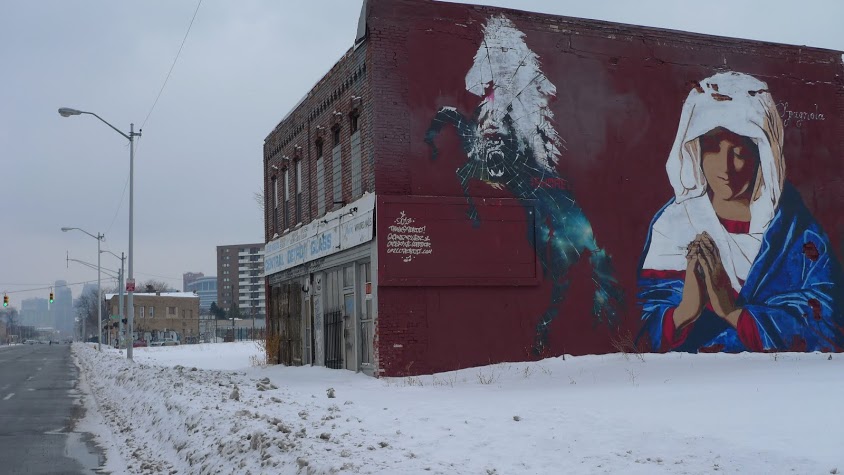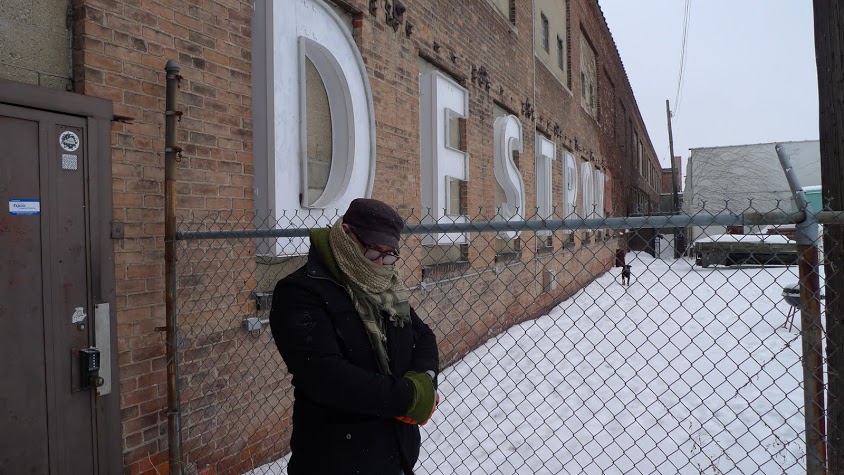Graffiti’s role in the revival of Michigan cities
The artist known as Fel3000ft -- Fel or Chase to his friends but no last names, please -- isn’t as young as he used to be. He claims to have been writing graffiti, legally and otherwise, longer than anyone else in Detroit. But it’s a young man’s game and, at 42, he’s starting to have health issues, pleurisy chief among them.
“I’m going to have to paint in a respirator, anyway,” he said on a frigid day in his unheated studio space on Detroit’s west side. “So I’m making a helmet. It’s going to have lights, and a servomechanism to open and close the visor.” Fel has an artist’s habit of seeing opportunities for expression everywhere.
And if you’re a graffiti artist – or writer, or vandal, depending on your point of view – no canvas is as big and appealing as Detroit, Flint and other Michigan cities that have unwittingly and unwillingly become draws for spray painting individuals bent on leaving their mark. An abandoned warehouse or factory may be an eyesore to most people, but to a street artist with a milk crate full of paint cans, it’s Xanadu.
Many have accepted the invitation. Besides locals like Fel, Detroit alone has been visited by Banksy, the near-mythical British artist so popular that his work has been jackhammered out of walls and transported to galleries; Katsu, a New Yorker who uses paint-filled fire extinguishers to scrawl his name on walls, a technique known elegantly as “pissing”; Nychos, whose “dissection” murals have appeared all over the world; and others. They’ve worked illegally in the middle of the night and under commission during the day. Like other up-from-the-street art forms, graffiti is considered legitimate in many circles.
Creative or curse
But not everyone in the gallery is pleased.
Despite the explosion of sanctioned graffiti, with artists invited by city fathers to paint murals on “permissible walls” and elsewhere, graffiti maintains its outsider-art status, delighting some and exasperating others. In Detroit and other cities working to revive its aging industrial core, there is growing debate over whether graffiti is a legitimate form of grassroots art that enlivens gray cityscapes, particularly blighted ones, or a plague that slows revival.
To critics, graffiti equals decay.
“All the graffiti in Flint is being treated as a blight problem,” said Flint Mayor Dayne Walling, who it’s safe to say is not a fan. “There are a number of wonderful community art murals around the city, agreed upon with property owners. But all the graffiti in Flint is considered blight.”
To that end, in Flint and elsewhere, volunteers struggle to keep up, regularly painting over graffiti, whether one-color Sharpie scribbles or more elaborate pieces. One successful strategy, Walling said, is to paint sanctioned murals over the highest-profile spots in town, effectively taking them out of circulation for the renegades.
But it’s a losing battle. As long as there is blight, abandoned buildings, and restless young people with access to paint, there will be graffiti. Those who create it say it would be better to accept and even encourage their work.
“There are two classes of (graffiti) writers,” said Charles Boike, a Flint lawyer. “There are taggers, guys who would tag [mark with their logo or signature] the Diego Rivera murals. Others follow the rules: Don’t tag existing business or occupied houses. Save it for a public place.”
Boike, 30, occupies a niche that gives him a unique perspective.
“I had the same story almost all graffiti writers have: I had a friend who was into graffiti, was taken to a viaduct to tag and fell in love with it.”
As a teen, Boike dove “into hip-hop culture, and it all went hand in hand. Eminem’s ‘8 Mile’ turned my life into a cliche – battle rapping, skating, all that. I became enticed by the fame aspect, where you use it to gain recognition. It’s very cheap for a kid to buy a can of spray paint and get your name known.”
But as frequently happens, the teenager found himself in trouble, dropping out of high school and spending a year on probation for writing graffiti in East Lansing.
His story has a happy, or at least more conventional ending, though; he served his probation, moved to Chicago and enrolled in art school, then law school. Today he finds himself in the position of being perhaps the only member of the Michigan Bar who can sling a spray can with the best of them. Last summer, he organized Aerosol & Audio, a graffiti and music festival in Flint. It featured a long wall of plywood sheets, upon which anyone could paint what they wanted.
But even he knows that won’t satisfy a lot of artists.
“It’s hard to explain, but the (graffiti) culture looks for edginess,” he said. “Art becomes edgy if you take risks, and graffiti writers take risk. They risk their freedom.” Boike no longer paints illegally, but he still paints – commissions and on permissible walls. That alone makes him semi-domesticated, but lawyers have to follow the law.
Making renegade legal
In Detroit, Derek Weaver is doing similar work, corraling artists into doing their best work on the many blank walls of the newly christened Grand River Creative Corridor, a neighborhood revitalization project on Grand River between Warren and Rosa Parks, on Detroit’s west side.
Where once block after block of abandoned real estate attracted run-of-the-mill taggers, today it boasts more colorful, ambitious murals; a madonna at prayer rises two stories, across from an industrial fastenings firm whose street-facing wall sports gamboling bolts and screws. No, it’s not your dad’s Detroit. But it’s the one we have now.
“Instead of saying, ‘How can we revive a city?’ we have to go to successful urban areas and ask why they’re thriving,” Weaver said. “For me, it’s a whole breakdown. Art and culture is a key ingredient in any successful urban area. We already have the institutions, the DIA and smaller art galleries. But Detroit has an abundance of buildings that present an opportunity to bring in street art and showcase it.”
Whether you regard graffiti as vandalism or street art is mainly a matter of age and attitude, Weaver said. The younger you are, the more likely you are to accept it as part of the urban streetscape, the same way you accept that a person with many tattoos is not necessarily a creep, contrary to your grandmother’s opinion.
But it’s a continuum. The artist known as Fel admits as much. Graffiti artists aren’t born able to execute elaborate, beautiful murals. They have to practice, and vandalize, a lot of boxcars, blighted buildings and other surfaces before they are capable of doing better work. In the ‘80s, when he got started, Fel himself would ride up to Detroit from his childhood home in Ecorse, hopping buses or trains, jumping on and off to “bomb” his favorite street spots.
This earlier, sketchier, illegal work is as important as the larger pieces he now creates with the city’s blessing, said Fel, who is one of the Grand River Creative Corridor artists, and whose legal, commissioned work can be seen elsewhere in the city, including the Dequindre Cut recreation path, on Vernor Highway and Corktown, among other places.
Fel and Boike, the lawyer, see themselves as part of a legitimate camp in the arts community, their status affirmed every time “I see traditional graffiti lettering and fonts used by corporate entities who want to make themselves hip,” said Boike. Fel points out that the London neighborhoods bombed by Banksy become immediate tourist destinations, even as authorities rush to cover them up.
“All we’re trying to do it take an abandoned and beat-up building and try to beautify it,” he said.
Still, less-talented writers dog Michigan’s cities. Last year, some person or persons climbed the scaffolding supporting overhead signs on many Detroit freeways and tagged them with white spray paint. It’s an act of extreme physical recklessness, one that MDOT spokeswoman Diane Cross says will likely not be eradicated any time soon – the department’s maintenance budget has already been hollowed out by the harsh winter.
Even that vandalism draws at least some respect. Matt Naimi, who has turned his sprawling recycling center in Detroit over to artists who want to paint, is awed by their work.
“I respect the idiot. Some dude climbed up there just to paint his name? Damn.”
See what new members are saying about why they donated to Bridge Michigan:
- “In order for this information to be accurate and unbiased it must be underwritten by its readers, not by special interests.” - Larry S.
- “Not many other media sources report on the topics Bridge does.” - Susan B.
- “Your journalism is outstanding and rare these days.” - Mark S.
If you want to ensure the future of nonpartisan, nonprofit Michigan journalism, please become a member today. You, too, will be asked why you donated and maybe we'll feature your quote next time!


 A two-story Madonna at prayer is one of the bigger pieces in the Grand River Creative Corridor’s footprint in Detroit, a space where graffiti is explicitly permitted. (Photo by Nancy Derringer)
A two-story Madonna at prayer is one of the bigger pieces in the Grand River Creative Corridor’s footprint in Detroit, a space where graffiti is explicitly permitted. (Photo by Nancy Derringer) The artist who signs his work Fel3000ft doesn’t like to show his face, but has pieces in or around a recycling center on Holden Street in Detroit. (Photo by Nancy Derringer)
The artist who signs his work Fel3000ft doesn’t like to show his face, but has pieces in or around a recycling center on Holden Street in Detroit. (Photo by Nancy Derringer)